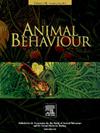How coevolution in daily activity rhythms governs encounters between predator and prey
IF 2.3
2区 生物学
Q2 BEHAVIORAL SCIENCES
引用次数: 0
Abstract
Predation risk in the wild varies across the day in a relatively predictable way, as a function of environmental conditions, such as light intensity and temperature, and of predator habits. Prey animals can thus adjust their own activity rhythm to avoid the most dangerous periods. We studied this situation in a coevolutionary perspective, considering that, if prey spread their activity across the day to counter predator temporal preferences, these preferences may in turn change to track prey activity. We therefore built a game-theoretical model to derive evolutionarily stable activity patterns for a predator constantly trying to maximize its chance of capture and a prey trying to minimize this probability. Key parameters concern circadian variations in environmental conditions and their influence on predator hunting efficiency and energy demands of the prey, which dictate its total amount of activity. The model predicts high levels of prey activity during periods of reduced predator efficiency. The predator may then either track these activity peaks and copy the activity patterns of its prey, or concentrate its hunting effort during periods when prey activity is low but conditions favour hunting. In the first case, predator and prey activity patterns will be synchronized. In the second one, they will exhibit strong temporal segregation. We show how these diverging scenarios emerge and how they can help to disentangle the wide variety of situations existing in the wild.
求助全文
约1分钟内获得全文
求助全文
来源期刊

Animal Behaviour
生物-动物学
CiteScore
4.60
自引率
8.00%
发文量
236
审稿时长
10.2 weeks
期刊介绍:
Growing interest in behavioural biology and the international reputation of Animal Behaviour prompted an expansion to monthly publication in 1989. Animal Behaviour continues to be the journal of choice for biologists, ethologists, psychologists, physiologists, and veterinarians with an interest in the subject.
 求助内容:
求助内容: 应助结果提醒方式:
应助结果提醒方式:


